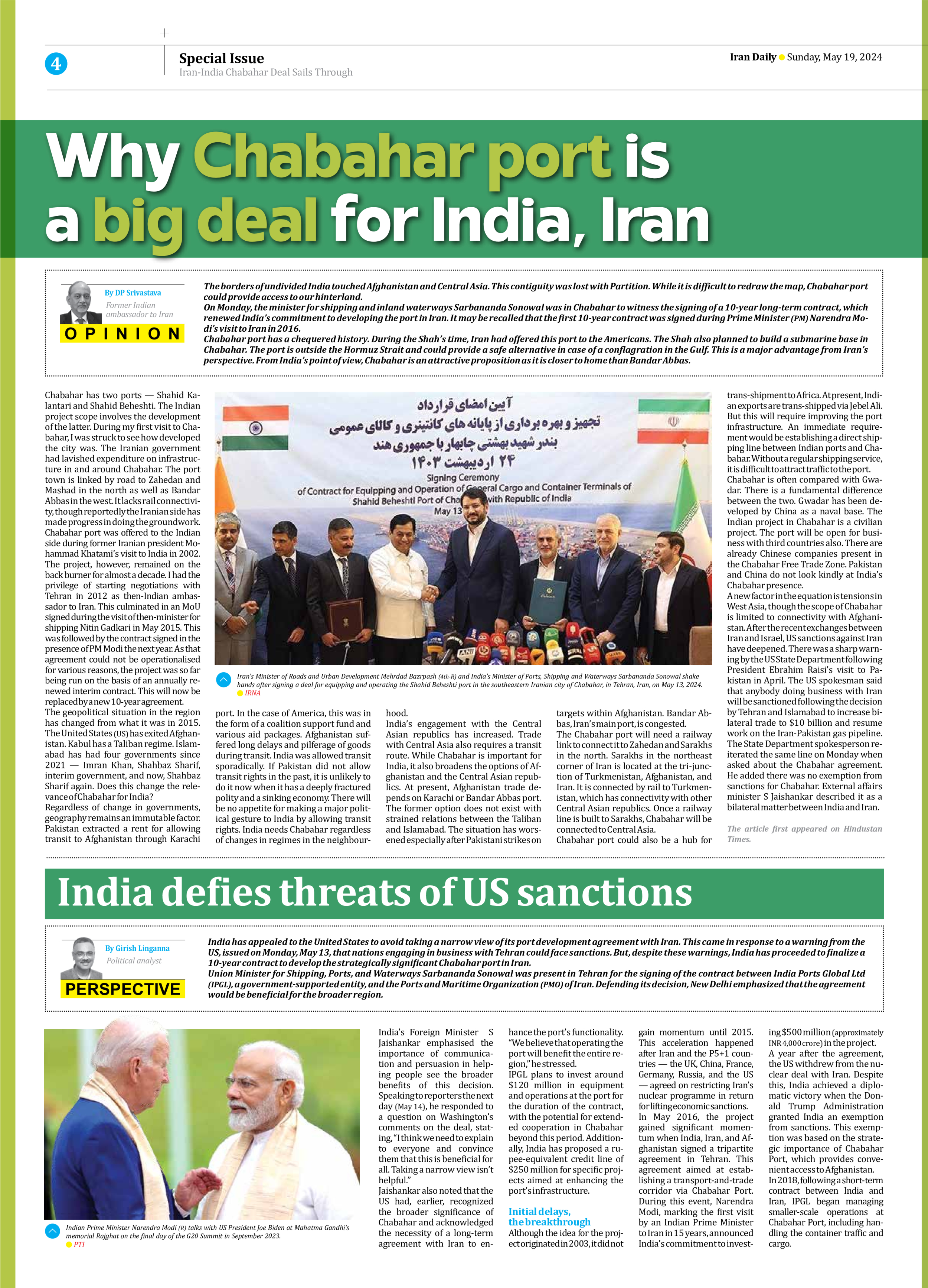
India defies threats of US sanctions
India has appealed to the United States to avoid taking a narrow view of its port development agreement with Iran. This came in response to a warning from the US, issued on Monday, May 13, that nations engaging in business with Tehran could face sanctions. But, despite these warnings, India has proceeded to finalize a 10-year contract to develop the strategically significant Chabahar port in Iran. Union Minister for Shipping, Ports, and Waterways Sarbananda Sonowal was present in Tehran for the signing of the contract between India Ports Global Ltd (IPGL), a government-supported entity, and the Ports and Maritime Organization (PMO) of Iran. Defending its decision, New Delhi emphasized that the agreement would be beneficial for the broader region.
By Girish Linganna
Political analyst
India’s Foreign Minister S Jaishankar emphasised the importance of communication and persuasion in helping people see the broader benefits of this decision. Speaking to reporters the next day (May 14), he responded to a question on Washington’s comments on the deal, stating, “I think we need to explain to everyone and convince them that this is beneficial for all. Taking a narrow view isn’t helpful.”
Jaishankar also noted that the US had, earlier, recognized the broader significance of Chabahar and acknowledged the necessity of a long-term agreement with Iran to enhance the port’s functionality. “We believe that operating the port will benefit the entire region,” he stressed.
IPGL plans to invest around $120 million in equipment and operations at the port for the duration of the contract, with the potential for extended cooperation in Chabahar beyond this period. Additionally, India has proposed a rupee-equivalent credit line of $250 million for specific projects aimed at enhancing the port’s infrastructure.
Initial delays,
the breakthrough
Although the idea for the project originated in 2003, it did not gain momentum until 2015. This acceleration happened after Iran and the P5+1 countries — the UK, China, France, Germany, Russia, and the US — agreed on restricting Iran’s nuclear programme in return for lifting economic sanctions.
In May 2016, the project gained significant momentum when India, Iran, and Afghanistan signed a tripartite agreement in Tehran. This agreement aimed at establishing a transport-and-trade corridor via Chabahar Port. During this event, Narendra Modi, marking the first visit by an Indian Prime Minister to Iran in 15 years, announced India’s commitment to investing $500 million (approximately INR 4,000 crore) in the project.
A year after the agreement, the US withdrew from the nuclear deal with Iran. Despite this, India achieved a diplomatic victory when the Donald Trump Administration granted India an exemption from sanctions. This exemption was based on the strategic importance of Chabahar Port, which provides convenient access to Afghanistan.
In 2018, following a short-term contract between India and Iran, IPGL began managing smaller-scale operations at Chabahar Port, including handling the container traffic and cargo.
Over the past six years, Chabahar Port has seen significant activity, managing over 90,000 vessels transporting more than 8.4 million tons of cargo. Additionally, India has utilized this port to deliver 2.5 million tons of wheat and 2,000 tons of pulses to Afghanistan.
Chabahar access:
geopolitical dynamics
Chabahar is a deep-water port located in Iran’s Sistan and Baluchistan province. It is the Iranian port nearest to India and is situated directly on the open sea, allowing large cargo ships to access it easily and securely. The Chabahar project includes two separate ports — Shahid Beheshti and Shahid Kalantari. India’s investment is focused specifically on the Shahid Beheshti Port.
Chabahar’s strategic position, situated west of Iran’s border with Pakistan and near the rival Gwadar port, enhances its appeal to India. Chabahar Port is significantly close to Gujarat on India’s west coast and is only 768 nautical miles from Mumbai.
During the 2016 agreement signing in Tehran, Union Transport Minister Nitin Gadkari highlighted, “The distance from Kandla, in Gujarat, to Chabahar Port is even shorter than the distance from New Delhi to Mumbai.”
Additionally, Gwadar Port, in Pakistan, which has seen significant Chinese investment, is located just 170 kilometres east of Chabahar. This port also serves as the starting point for the China-Pakistan Economic Corridor (CPEC).
The significance of Chabahar Port increased after China began developing Pakistan’s Gwadar Port in 2002 as part of its ‘Belt and Road Initiative’, further cementing a partnership between both countries to establish a deep-sea port at Gwadar.
Chabahar Port offers India a direct sea-to-land route to Afghanistan and Central Asia, avoiding Pakistan. This route facilitates India’s ability to participate in trade and development initiatives in these areas, boosting regional connectivity and extending its influence.
India depends heavily on the Strait of Hormuz for its trade with Central Asia and Afghanistan. However, tensions in that region could disrupt this route. Chabahar Port offers India an alternative trade pathway, ensuring that, even if issues arise in the Strait of Hormuz, India can continue its trade activities safely. Thus, Chabahar Port enhances India’s trade security by providing additional options.
Chabahar is included in the planned International North-South Transport Corridor (INSTC), a diverse transport route that connects the Indian Ocean and the Persian Gulf to the Caspian Sea through Iran. From there, it extends to northern Europe via Saint Petersburg, in Russia.
Consequently, Chabahar Port is viewed as a key access point that could enhance India’s trade opportunities with Europe by offering a quicker route. According to industry estimates, shipping via the INSTC route could reduce transit time by 15 days compared to the traditional Suez Canal route.
The article first appeared on DNA India.







